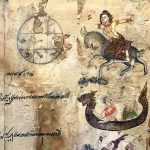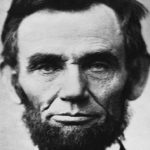 Weird Stuff
Weird Stuff  Weird Stuff
Weird Stuff  Our World
Our World 10 Ways Your Christmas Tree Is More Lit Than You Think
 Movies and TV
Movies and TV The 10 Coolest Stars to Set Sail on The Love Boat
 History
History 10 Things You Didn’t Know About the American National Anthem
 Technology
Technology Top 10 Everyday Tech Buzzwords That Hide a Darker Past
 Humans
Humans 10 Everyday Human Behaviors That Are Actually Survival Instincts
 Animals
Animals 10 Animals That Humiliated and Harmed Historical Leaders
 History
History 10 Most Influential Protests in Modern History
 Creepy
Creepy 10 More Representations of Death from Myth, Legend, and Folktale
 Technology
Technology 10 Scientific Breakthroughs of 2025 That’ll Change Everything
 Weird Stuff
Weird Stuff Ten Bizarre Facts About The Doge Meme
 Our World
Our World 10 Ways Your Christmas Tree Is More Lit Than You Think
 Movies and TV
Movies and TV The 10 Coolest Stars to Set Sail on The Love Boat
Who's Behind Listverse?

Jamie Frater
Head Editor
Jamie founded Listverse due to an insatiable desire to share fascinating, obscure, and bizarre facts. He has been a guest speaker on numerous national radio and television stations and is a five time published author.
More About Us History
History 10 Things You Didn’t Know About the American National Anthem
 Technology
Technology Top 10 Everyday Tech Buzzwords That Hide a Darker Past
 Humans
Humans 10 Everyday Human Behaviors That Are Actually Survival Instincts
 Animals
Animals 10 Animals That Humiliated and Harmed Historical Leaders
 History
History 10 Most Influential Protests in Modern History
 Creepy
Creepy 10 More Representations of Death from Myth, Legend, and Folktale
 Technology
Technology 10 Scientific Breakthroughs of 2025 That’ll Change Everything
Top 10 of History’s Most Lethal Leaders
History is sadly filled with one genocide after the other, and as technology improved, so too did our ability to kill one another en masse. Of course, technology isn’t the only key to killing millions of people, and some of history’s most lethal leaders relied on weapons we consider to be archaic today.
Regardless, many military and political leaders are responsible for the deaths of millions of people, either directly or indirectly, whether they were dictators or duly elected politicians. While not all numbers are 100% verifiable, these leaders are history’s most lethal.
Related: Top 10 Forgotten War Criminals Sentenced To Death
10 Ismail Enver Pasha–2.85 Million
While his name isn’t well known to those outside of history classrooms, Ismail Enver Pasha is one of the principal military architects of the Ottoman Empire during WWI. After the assassination of Archduke Franz Ferdinand, the Ottomans and its allies teamed up to take on the world in the so-called “Great War,” leading to approximately 40 million deaths. And Pasha was responsible for nearly three million of those.
Pasha formed one-third of the Ottoman dictatorial triumvirate known as the Three Pashas, and he was the de facto Commander in Chief. Pasha instigated the Late Ottoman genocides responsible for slaughtering upward of 1.8 million Armenians, 300,000 Assyrians, and 750,000 Greeks. The Ottoman genocide of these three groups took place between 1915 and 1923.
The Ottoman genocides targeted Christian minorities within the empire by various methods. Many were forced into death marches, resulting in deaths from disease, starvation, and direct action. History turned a somewhat blind eye to the genocides due to the overarching conflict of WWI, and it’s since come into greater focus in the 21st century.[1]
9 Yahya Khan–3 Million
Yahya Khan served as Pakistan’s third president from 1969 to 1971, having previously and concurrently served as the Commander in Chief of the Pakistan Army. While he didn’t do it on his own, Khan was the principal architect of the 1971 Bangladesh genocide. The genocide resulted in the deaths of some three million Bengals living in East Pakistan, which is now Bangladesh. The conflict arose due to an ongoing movement for Bengali independence, which Khan brutally opposed.
The Bangladesh genocide lasted from March until December 1971 and was the result of a large-scale military escalation by Pakistan. The Pakistani army and pro-Pakistani militias killed, raped, and brutalized an unknown number of people, with estimates ranging from between 500,000 and three million in total.
Pakistan primarily targeted Hindus, and there’s no doubt of Khan’s responsibility. On February 22, 1971, he famously said, “Kill three million of them, and the rest will eat out of our hands.” At the end of the conflict, tens of millions were displaced, Bangladesh formed, Pakistan surrendered to India, and Khan entered house arrest until 1979.[2]
8 Hideki Tojo–4 Million
Years before WWII raged in Europe, Japan invaded numerous nations, including China, Korea, the Philippines, and Manchuria, where the Imperial Japanese Army conducted a campaign of brutal genocide as it took hold of mainland Asia. The man principally responsible for this was Hideki Tojo, who served as a General and Chief of Staff of the Kwantung Army before elevating to become the Prime Minister of Japan from 1941 until 1944.
As Prime Minister, Tojo pushed for a preemptive attack on the United States, and we all know how that turned out. In Asia, he led his forces across civilian lands throughout the continent, slaughtering people in what became known as the Asian Holocaust. During this time, Japanese forces carried out biological and chemical attacks, placed civilians into sexual slavery, and slaughtered others.
By the end of the war, Tojo’s actions resulted in the deaths of some four million people, and he paid for his crimes. After the war, Tojo was charged and convicted of committing war crimes and was subsequently hanged for his actions.[3]
7 George W. Bush–4.6 Million
Just under eight months into George W. Bush’s first term as President of the United States, terrorists attacked. On September 11, 2001, a coordinated terrorist attack instigated by Al-Qaeda destroyed prominent buildings and killed nearly 3,000 Americans. Bush responded as many U.S. Presidents would—with the full force of the military, resulting in two of the nation’s most protracted conflicts.
The so-called “Global War on Terror” focused primarily on two nations, Afghanistan and Iraq, resulting in Operation Enduring Freedom and Operation Iraqi Freedom, respectively. Those two wars raged on in varying degrees of American and NATO commitment for two decades, and the human toll was immense.
Either through direct or indirect action, the Global War on Terror resulted in an estimated 4.6 million deaths. While the conflicts wouldn’t have arisen had Al-Qaeda not attacked on 9/11, U.S. military action, while calculated, resulted in the deaths of millions. Deaths resulted from military action, causing widespread environmental, medical, and economic degradation. Three subsequent presidents took part in the war launched by Bush, so plenty of people played their part.[4]
6 King Leopold II–10 Million
Leopold II ruled as the second King of the Belgians from 1865 until 1909, and he was also responsible for the deaths of millions in his quest to establish the Congo Free State. After seizing control of the Congo, he put its people to work (against their will). He brutalized the population in his campaign to strip the area of its ivory, rubber, and other natural resources. Leopold tasked his commanders with using violence and whatever means necessary to accomplish his goals.
“Whatever means necessary” included everything from beating innocent people to cutting off appendages, burning buildings, enslaving children, torture, and murder. The brutality of Leopold’s exploitation of the Congo and its people can be seen as a blueprint for the genocides that followed. It was one of the first industrialized “crimes against humanity” committed by a European monarch, though it wouldn’t be the last.
Leopold’s campaign resulted in a massive number of deaths, though the exact number is unknown. Some estimates put Leopold’s direct and indirect kill count at 10 million Congolese people, with many attributable to famine and disease caused by Leopold’s regime.[5]
5 Hong Xiuquan–30 Million
Hong Xiuquan was a Chinese revolutionary leader responsible for instigating the Taiping Rebellion against the Qing dynasty. The Taiping Rebellion began in December 1850 and continued until August 1864. It resulted from Xiuquan’s establishment of the Taiping Heavenly Kingdom, of which he named himself its “Heavenly King.” As the newly established monarch of a region within China, Xiuquan quickly found himself at odds with the Qing dynasty, resulting in a massive civil war.
Xiuquan established his reign as a Christian and declared that he was the brother of Jesus Christ, but he wasn’t the leader of a small cult. At its height, Xiuquan ruled over 30 million Chinese people, so the ensuing conflict resulted in widespread deaths. Like many of history’s significant conflicts, it’s difficult to ascertain the total number killed due to Xiuquan’s actions, but there are estimates.
It is believed that Xiuquan is responsible for the deaths of 30 million people, many of whom were civilians. Many died from direct military engagement, while many more died from famine and disease brought by the Taiping Rebellion.[6]
4 Adolf Hitler–35.2 Million
For most people, Adolf Hitler’s name pops up when thinking about the deadliest dictator in history, but he’s not even close to the worst of them. That’s not to say he wasn’t responsible for millions of deaths, but the numbers are often difficult to pin down. Just looking into the Holocaust of European Jews and other “undesirable” members of Hitler’s ideal society, some 20.9 million perished through systematic extermination.
That number includes approximately six million Jews, 7.8 million Soviet civilians and POWs, and hundreds of thousands of Serbians, Poles, Romani, and more. Of course, in addition to the Holocaust, Hitler’s operations across Europe and Africa resulted in the deaths of many more, including his military, which consisted almost entirely of the young and elderly by the end of WWII.
Germany lost upward of 14.3 million military personnel and civilians through combat, and Hitler was responsible for every one of those deaths. While the numbers aren’t entirely known, Hitler is responsible for approximately 35.2 million deaths across Europe, Africa, and elsewhere.[7]
3 Genghis Khan–40 Million
Genghis Khan founded the Mongol Empire and ruled it from 1206 until 1227. He was a brilliant and brutal military leader who united the Mongol tribes and led the largest contiguous empire in history. In his conquest of much of Central Asia, Khan led military engagements that resulted in millions of deaths. Khan led sieges against large cities, causing widespread starvation via his strategy of “total war.”
Khan believed his methods were necessary for achieving victory at all costs, and it’s hard to argue with his results. It’s estimated that Khan killed more than 40 million people, which was approximately 10% of the world’s population at the time. A 2015 study determined that the loss of so much life resulted in a reduction of CO2, causing a mini Ice Age at the beginning of the 14th century.
One could attribute deaths from that event to Khan, but that’s difficult to determine with certainty. What’s known is that Khan’s conquest of Asia resulted in tens of millions of deaths, enshrining him as one of the most controversial leaders in history.[8]
2 Joseph Stalin–40 Million
Joseph Stalin led the Soviet Union from 1924 until 1953. In the 1930s, Stalin consolidated his power and established a Soviet dictatorship, which remained in place until the fall of the USSR in 1991. In his rise to power, Stalin slaughtered anyone who got in his way and millions of Russian civilians who didn’t, many of whom died during the Great Purge.
Stalin forced Soviet agriculture into a collectivized state as he improved upon Soviet industrialization, taking lands and property from millions as millions more were killed or placed into forced labor camps. Many died from the horrible conditions of these camps or were executed as part of Soviet expansion policy, while millions more died as a result of a forced famine.
While Stalin sent his troops into combat during WWII, and many died, his war casualties pale in comparison to the number of Soviet citizens he killed throughout his brutal reign of terror. Estimates vary, but most place the number of dead at his command at 40 million, with some estimates passing 60 million.[9]
1 Mao Zedong–65 Million
Chairman Mao Zedong founded the People’s Republic of China in 1949 and remained its leader until his death in 1976. Mao’s policies helped establish a China that would become a significant international political power, and he managed this by killing more people than any other leader who preceded or followed him. While some minor policy changes caused the deaths or persecutions of many, Mao’s Great Leap Forward was responsible for the most deaths.
The Great Leap Forward was an economic and social campaign designed to transform the PRC from an agrarian society to an industrial one. This established policies that resulted in the Great Chinese Famine, which caused the deaths of 45 million people between 1958 and 1962. He followed this with the Cultural Revolution, which eliminated so-called “counter-revolutionaries” from Chinese society.
There are numerous estimates of how many people Mao was responsible for killing during his brutal reign. The most often-cited number is 65 million, though other estimates place the number north of 80 million. Sadly, the world will likely never know the true number who died as a result of Mao’s brutal policies.[10]








